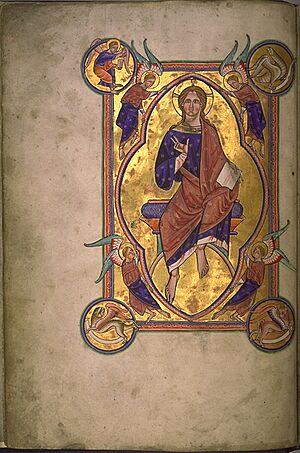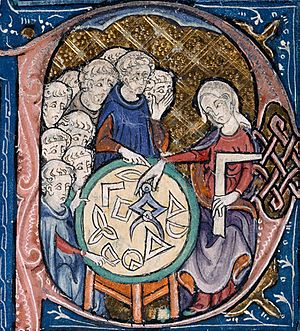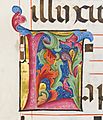Illuminated manuscript facts for kids
An illuminated manuscript is a special kind of manuscript (a book or document written by hand) that has been decorated. These decorations can include fancy initial letters, colorful borders, and small pictures called miniatures.
Originally, the word "illuminated" meant a manuscript decorated with shiny gold or silver. But today, we use the term for any handwritten book that has been decorated or illustrated.
Most illuminated manuscripts that we still have today come from the Middle Ages. Some also exist from the 15th century Renaissance, and a very few from ancient times. Many of these old books were religious, like Bibles or prayer books. However, after the 13th century, more and more everyday stories and non-religious texts also started to be decorated.
Most illuminated manuscripts were made as codices, which are like modern books with pages bound together. But some were made as rolls or single sheets. They were usually written on parchment (animal skin, like calf, sheep, or goat) or vellum (calf skin), which were specially prepared for writing. Later, in the late Middle Ages, some manuscripts began to be made on paper.
Illuminated manuscripts are very important because they are some of the best examples of painting that survived from the Middle Ages. For many places and times, they are the only artwork we have left!
Contents
How Were Illuminated Manuscripts Made?
Making an illuminated manuscript was a complicated and often expensive process. Because of this, these beautiful books were usually made for special purposes. For example, a church might order a richly decorated Bible for its altar. Wealthy people often had fancy "books of hours" made. These books contained prayers for different times of the day.
Writing the Text
The first step in making an illuminated manuscript was usually writing the text. Sheets of parchment or vellum were cut to the right size. These were animal hides specially prepared to be smooth and ready for writing.
After planning how the page would look (like where the big first letter or borders would go), the page was lightly marked with lines. Then, the scribe, who was the person writing, would use an ink-pot and a sharpened quill feather or a reed pen to write the words.
The style of writing, called the script, changed over time and depended on where the manuscript was made. In the early Middle Ages, strong Roman letters were common. Later, more flowing styles like Uncial and half-Uncial became popular, especially in the British Isles. Unique scripts like insular majuscule and insular minuscule also developed there. Around the 13th century, a thick, dark script called blackletter appeared. This style was very popular in the later Middle Ages.
Related pages
Images for kids
-
Illuminated manuscripts kept in a 16th-century Ethiopian Orthodox Church in Ura Kidane Mehret, Zege Peninsula, Lake Tana, Ethiopia.
-
An example of a French-Latin book of hours. The small pictures, called miniatures, were used to teach lessons. This is from the Book of Hours of Alexandre Petau, made in the 16th century in Rouen.
-
The 11th-century Tyniec Sacramentary was written with gold on a purple background. It is now in the National Library of Poland, Warsaw.
-
A page from a Byzantine Psalter and New Testament, made in 1079. It uses ink, tempera paint, and gold on vellum.
-
Definitions of Philosophy by David the Invincible, from 1280, written on vellum. It is kept in Matenadaran (Yerevan, Armenia).
-
A detailed view of a letter L from a Benedictine Antiphonary, by Belbello da Pavia. Made around 1467–1470 with tempera, gold, and ink on parchment.
-
The Farnese Hours, a beautiful example of a Renaissance illuminated page by Giulio Clovio. Made between 1537–1546, it is an illumination on parchment.
-
An illuminated Al-Quran from 1591–92, from Safavid Iran. It is now in the Turkish and Islamic Arts Museum (Istanbul).
See also
 In Spanish: Manuscrito ilustrado para niños
In Spanish: Manuscrito ilustrado para niños















